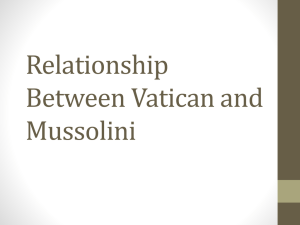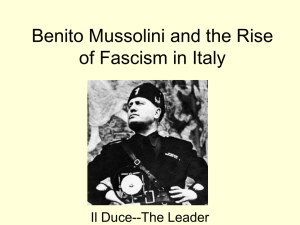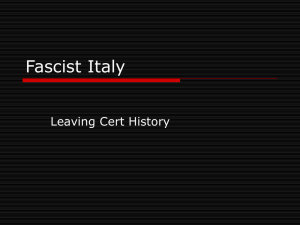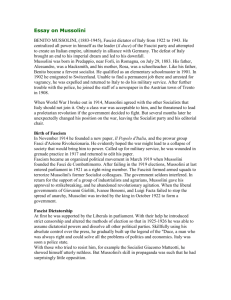File - Ms O`Keeffe`s History Class
advertisement
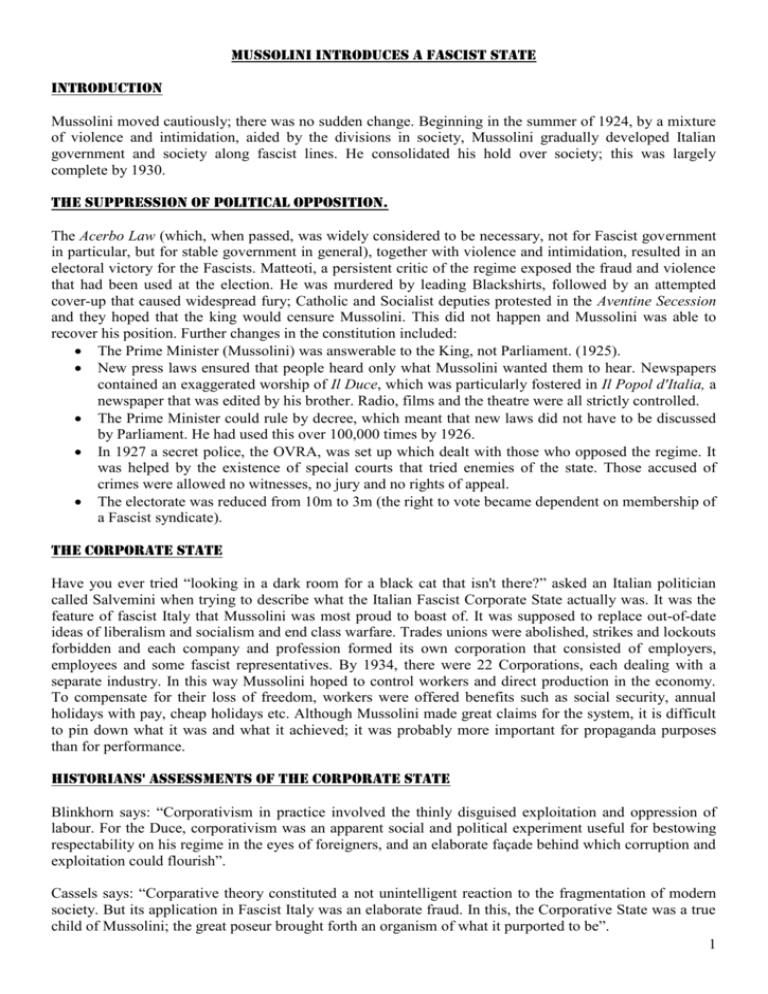
MUSSOLINI INTRODUCES A FASCIST STATE Introduction Mussolini moved cautiously; there was no sudden change. Beginning in the summer of 1924, by a mixture of violence and intimidation, aided by the divisions in society, Mussolini gradually developed Italian government and society along fascist lines. He consolidated his hold over society; this was largely complete by 1930. The Suppression of Political Opposition. The Acerbo Law (which, when passed, was widely considered to be necessary, not for Fascist government in particular, but for stable government in general), together with violence and intimidation, resulted in an electoral victory for the Fascists. Matteoti, a persistent critic of the regime exposed the fraud and violence that had been used at the election. He was murdered by leading Blackshirts, followed by an attempted cover-up that caused widespread fury; Catholic and Socialist deputies protested in the Aventine Secession and they hoped that the king would censure Mussolini. This did not happen and Mussolini was able to recover his position. Further changes in the constitution included: The Prime Minister (Mussolini) was answerable to the King, not Parliament. (1925). New press laws ensured that people heard only what Mussolini wanted them to hear. Newspapers contained an exaggerated worship of Il Duce, which was particularly fostered in Il Popol d'Italia, a newspaper that was edited by his brother. Radio, films and the theatre were all strictly controlled. The Prime Minister could rule by decree, which meant that new laws did not have to be discussed by Parliament. He had used this over 100,000 times by 1926. In 1927 a secret police, the OVRA, was set up which dealt with those who opposed the regime. It was helped by the existence of special courts that tried enemies of the state. Those accused of crimes were allowed no witnesses, no jury and no rights of appeal. The electorate was reduced from 10m to 3m (the right to vote became dependent on membership of a Fascist syndicate). The Corporate State Have you ever tried “looking in a dark room for a black cat that isn't there?” asked an Italian politician called Salvemini when trying to describe what the Italian Fascist Corporate State actually was. It was the feature of fascist Italy that Mussolini was most proud to boast of. It was supposed to replace out-of-date ideas of liberalism and socialism and end class warfare. Trades unions were abolished, strikes and lockouts forbidden and each company and profession formed its own corporation that consisted of employers, employees and some fascist representatives. By 1934, there were 22 Corporations, each dealing with a separate industry. In this way Mussolini hoped to control workers and direct production in the economy. To compensate for their loss of freedom, workers were offered benefits such as social security, annual holidays with pay, cheap holidays etc. Although Mussolini made great claims for the system, it is difficult to pin down what it was and what it achieved; it was probably more important for propaganda purposes than for performance. Historians' assessments of the Corporate State Blinkhorn says: “Corporativism in practice involved the thinly disguised exploitation and oppression of labour. For the Duce, corporativism was an apparent social and political experiment useful for bestowing respectability on his regime in the eyes of foreigners, and an elaborate façade behind which corruption and exploitation could flourish”. Cassels says: “Corparative theory constituted a not unintelligent reaction to the fragmentation of modern society. But its application in Fascist Italy was an elaborate fraud. In this, the Corporative State was a true child of Mussolini; the great poseur brought forth an organism of what it purported to be”. 1 Economic Policy Mussolini aimed first and foremost at autarky or self-sufficiency, especially in food production. Such a priority was not surprising for a strongly nationalist government that considered war inevitable; it also tied in with his dislike of cities and urbanisation, for peasants were more necessary to Fascism than intellectuals or town artisans. The Battle for Grain was launched in 1925 and attempted to boost cereal production and make Italy self-sufficient in grain. High import taxes were placed on foreign grain. There was a loss of export markets for the produce from the land which had been converted to cereals. Also, Italy's climate was not particularly suitable for cereal growing and so the yield was relatively low. Thus, wheat imports fell by 75% and, though Italy became self-sufficient in cereals by 1940, the cost of grain was higher, there was a decline in the quality of the Italian diet and egg production increased. The Battle of the Marshes was more successful although much less land was reclaimed than fascist propaganda portrayed. A great deal of money was allocated to the drainage of malarial infested marshes at Pontine, near Rome. It had a bigger impact in providing jobs and improving public health than in boosting farming. There was clear progress in transport, particularly in prestige projects. Autostrada were built and 5,000 kilometres of railways were electrified, but roads remained in bad condition in poor areas. For the first time in history, Italian trains ran on time. This public works programme tried to cure the worst aspects of unemployment. An unusual battle was the Battle for Births, which aimed at encouraging marriage and parenthood and imposed taxes on bachelorhood from 1926 onwards. The revaluation of the lira, which occurred in 1926, revalued the lira far too highly in an attempt to demonstrate how strong the currency was. The effect of this was to make Italian exports very expensive. By the late 1930s military spending was placing an enormous burden on Italy's economic resources. Church-State Relations and the Lateran Accords of 1929 The Papacy had been hostile to the Italian government since 1870, when all Papal territory had been incorporated into the new Italian state. Although he was initially sympathetic to Mussolini, Pope Pius XI disapproved of the totalitarianism of the regime. Although an atheist himself, Mussolini was aware of the power of the Roman Catholic Church and exerted himself to win the Pope's support by exploiting his fear of communism. The result was the Lateran Pact of 1929 by which Italy recognised the Vatican City as a sovereign state, accepted the Roman Catholic faith as the state religion and made religious instruction compulsory in all schools. In return, the Pope recognised the kingdom of Italy. Some historians see the ending of the long breach between church and state as Mussolini's most worthwhile achievement. MUSSOLINI - THE CONSOLIDATION OF POWER Key Dates: OCTOBER 1922: Mussolini appointed Prime Minister in a coalition government. NOVEMBER 1922: Mussolini given the right to rule by decree for 12 months. DECEMBER 1922: Mussolini strengthens his control of the fascist movement. JULY 1923: parliament passed the Acerbo Law changing the electoral system to give the most popular party a majority. JUNE 1924: the murder of Matteoti created a crisis for Mussolini and led to the emergence of a dictatorship. JULY 1924: the emergence of press censorship. JAN 1925: Mussolini announced his intention of creating a dictatorship. OCT 1925: free trade unions were banned. JAN 1926: Mussolini assumed the right to make laws without the consent of parliament. 2 Mussolini did not gain total power in 1922. He was at the head of a moderate coalition containing only four Fascist ministers and out of a parliament of 535 deputies the Fascists had only 35. Mussolini aimed at a personal dictatorship, but he was cautious and proceeded through constitutional means. Here were a number of factors that enabled Mussolini to consolidate his hold on power: There was a fatal miscalculation that the fascist party would be so grateful that it was allowed into the existing power structure that Mussolini would be transformed into a respectable politician and that as a traditional politician a position for him could be found within the power structure. By the time that these other politicians realised their mistake, it was too late and the dictatorship was in place. They genuinely believed that any powers they granted him would be ended as soon as possible. The new Prime Minister, Mussolini, demanded that he should have the right to rule by decree for 12 months; this effectively meant that he was able to pass laws without consulting parliament. It was justified on the grounds that it was necessary to secure law and order. Mussolini skilfully exploited the left-wing threat posed by the possibility of a Bolshevik style revolution although the socialist threat was negligible and the main threat to law and order came from the Fascist squads – the paramilitary Blackshirts. In order to strengthen his position, Mussolini introduced a significant measure of electoral reform – the Acerbo Law, which was designed to give the leading party two-thirds of the seats in parliament. In the election of 1924, in an atmosphere of widespread Blackshirt violence and ballot-rigging, the Fascists won the most votes and took 374 seats our of a possible 535. Nevertheless, the socialist parties also did well which showed that there was opposition to the Fascists. In the summer of 1924, the socialist deputy, Giacomo Matteoti, a particularly strong opponent of Mussolini, was found murdered by a gang of Fascists. This brutal murder was condemned and for a while Mussolini’s position was very shaky. The Nationalists and Conservatives continued to support him in a bid to ensure that no revival of left-wing power took place. Some deputies seceded in protest and this so-called “Aventine Secession” simply made Mussolini stronger. The king did not demand his resignation and Fascist forces urged him on to establish a more dictatorial regime. Emergence of a dictatorship: while his position was still being supported by Liberals and Conservatives, he took steps to prevent any further opposition. In July 1924, he introduced press censorship. The following month he banned meetings by opposition parties. In January 1925, Mussolini announced his intention to create a dictatorship – the opposition was divided, lacking in leadership and compromised by its earlier support for the Fascists. In December, opposition parties were banned and so were free trade unions. A new secret police, the OVRA, was set up and a court to try political crimes. In January 1926 Mussolini was granted the right to issue decrees that had the full force of law, which meant that Mussolini could dispense with parliament. The King lost the power to select the Prime Minister – the candidates would be controlled by the Fascists under the control of Mussolini. Essay Questions on the Rise of Fascism in Italy Essay questions on the reasons for the growth and success of fascism are very common. Another common type of question is for the candidate to be presented with one or two possible factors and asked to assess their significance. Example: “What factors promoted the growth of fascism in Italy?” This is a straightforward essay. The one pitfall to avoid is that you must not simply give a narrative or a list of events. You should also think carefully about the dates in the question; you may be required to look at the emergence of the dictatorship after 1922, in addition to looking at the years between 1918-22 in detail. You should try to supply a list of reasons, which may include as many as 12, and then try to put them into 3 general categories such as ‘weaknesses of the regime’, ‘legacy of the WWI’, ‘Mussolini’s political skills’ etc. Each category should be dealt with in a separate paragraph and at the beginning of each paragraph you should discuss the general importance of that particular category in bringing about the growth of fascism and then give more detail. Another type of question might give some reasons – such as the mutilated victory in the First World War and the socialist threat and then ask you to assess how important these factors were. You have to decide how critical these factors were and if you decide that they were the most critical you must spend most of your essay explaining why this was the case. If you decide this was not the case then you should state this in your opening paragraph and you should state what were the critical factors. You should explain the significance of socialism and the mutilated victory briefly, and then go on to discuss the other important factors 4


